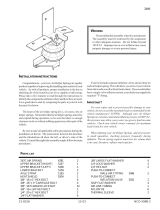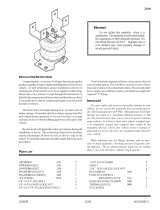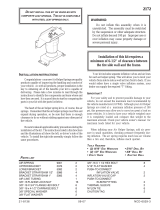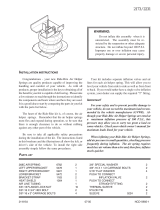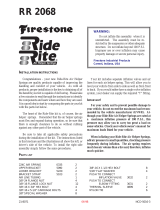Page is loading ...


2
Item Description Quantity
A Air Springs 2
B Roll Plates 4
C Upper Bracket 2
E Retaining Brackets 4
F Lower Brackets 2
G Heat Shield Kit 1
I 3/8” x 7/8” Hex Head Bolts 12
J 3/8” x 2” Hex Head Bolts 4
K 5/16” Clinch Bolt (Driver’s Side Only) 1
L 3/8” Lock Nut 4
M Flat Washer 21
N 5/16” Lock Nut (Driver’s Side Only) 1
O 3/8” Whiz Nut 4
P Hose Clip (Driver’s Side Only) 1
S Lock Washers 8
T 90° Swivel Fitting 2
AA Air Line Assembly 1
BB Tie Strap 6
CC Valve Caps 2
DD 5/16” Flat Washers 2
EE Rubber Washer 2
FF Star Washer 2
GG 5/16” Hex Nut 4
HH Thermal Sleeve 2
Hardware List

9/16” open-end or box wrenches
Ratchet with 15mm, 7/16”, 9/16”
and 1/2” deep well sockets
3/8” and 5/16” drill bits (very sharp)
Heavy Duty Drill
Torque Wrench
3
Hose Cutter, Razor Blade, or Sharp
Knife
Hoist or Floor Jacks
Safety Stands
Safety Glasses
Air Compressor, or Compressed Air
Source
Spray Bottle with Dish Soap/Water
Solution
Tools Needed
Before You Start
You need to determine Normal Ride Height. Normal Ride Height is the distance between the bottom
edge of the wheel well and the center of the hub with the vehicle in the “as delivered” condition. In
some cases, Normal Ride Height is not perfectly level.
Remove unusual loads and examine your
vehicle from the side to ensure it is on a level
surface. If necessary (in cases where your
leaf springs are sagging badly), use a jack to
raise the rear end so that the vehicle achieves
the original “as delivered” ride height.
Measure the distance between the center of
the hub and the bottom edge of the wheel
well. This is the Normal Ride Height. Enter
the measurement below:
NORMAL
RIDE HEIGHT: ______________ inches
IMPORTANT: Your vehicle may be equipped with a rear brake proportioning
valve. Any type of load assist product could affect brake performance. We
recommend that you check with your dealer before installing this type of
product. If your vehicle DOES NOT have a rear brake proportioning valve or
is equipped with an anti-lock type brake system, installation of a load assist
product will have NO EFFECT ON BRAKE SYSTEM PERFORMANCE.
CAUTION: Compressed air can cause injury and damage to the vehicle and
components if it is not handled properly. For your safety, do not try to inflate
the air springs until they have been properly secured to the vehicle.
Figure 3
Figure 2

DRIVERS SIDE ONLY - Insert 5/16 clinch bolt (K)
into the small hole of the lower bracket before
attaching the lower bracket to the air spring.
Supporting the lower bracket will ease installation
of the clinch bolt. Use a hammer to drive the bolt
into the hole in the lower bracket (Fig. 7).
4
Assembling the Air Spring Unit
Attach the upper brackets (C) to the air springs
with two 3/8-24x7/8” hex head bolts (I),
lockwashers(S) and flat washers (M). Leave loose
at this time (Fig. 5).
Note: It will be necessary to use the correct holes
for driver and passenger side mounting. See
diagram to correctly index the bellows and the
upper bracket (Fig. 6).
Set a roll plate (B) on both ends of the air spring
(A). The radiused (rounded) edge of the roll plate
will be towards the air spring, so that the air
spring is “seated” in both roll plates (Fig. 4).
Figure 6
Figure 7
Figure 5
Figure 4
Frame
Mounting
Slots
Wheel (Outboard)
Use these holes to
mount on the
driver's side
Use these holes to
mount on the
passenger's side
Frame
Mounting
Slots
Top View

Clinch bolt
5
The lower bracket must be attached with the small
hole in the lower bracket on the same side as the
air port in the air spring.
Note: Be sure to install the assembly with the
clinch bolt on the driver side. Refer to diagram
(Fig. 7) on page 4.
Removing Jounce Bumper
Using a 15mm Socket, remove the jounce
bumper from the frame rail (Fig. 10).
The style of jounce bumper will vary depending
on the model of the truck.
Attach the air spring to the lower bracket. Secure
the lower bracket (F) to the air spring (A) with two
3/8-16x7/8” hex head bolts (I), lockwashers (S)
and flat washers (M).
Torque to 20 ft. lbs. It may be helpful to use a
socket to install the mounting hardware.
CAUTION-Do not cross thread the bolt.
Figure 8
Figure 9
Figure 10

Set whiz nut (O) up inside of the upper bracket
(Fig. 12 & 13) with flange up (Fig. 12).
Hold in place with an open end 9/16” wrench.
Put 3/8”x7/8” hex head bolts (I) with flat washers
(M) down through the existing jounce bumper hole
from the inside of the frame, and attach to the
whiz nuts (Fig. 13). Leave loose for adjustment
later.
6
Attaching the Air Spring Assembly
Set assembly on the axle with the air port on top of the bellows toward the inside of the frame
rail (Figure 1).
Note: Reference Assembling the Air Spring Unit (page 4), Attaching the Upper Bracket, for
driver side and passenger side assemblies.
On some models the jounce bumper may be
attached to the frame with a bracket.
Remove the entire jounce bumper bracket and
the jounce bumper from the frame rail (Fig. 11).
Figure 11
Figure 12
Figure 13

Secure the lower bracket to the jounce bumper
strike pad using the retaining bracket (E),
3/8”x2” hex head bolt (J), flat washers (M) and
3/8” lock nut (L) (Fig. 14).
7
Figure 14
The short leg of the retaining bracket must be
under the edge of the jounce bumper strike pad.
Tighten evenly front to back to keep the lower
bracket flat and centered on the jounce bumper
pad.
Center the upper bracket, so the bolts are in the
center of the slots (Fig. 15).
Adjust bellows at top so bellows is perpendicu-
lar to both upper and lower brackets.
Passenger's Side
Driver's Side
Figure 15
Figure 16
Tighten both bellows to top bracket mounting bolts
(Fig. 16).
Tighten bracket to frame mounting hardware.

Slide the provided clip (P) onto the rubber coated brake line
(Fig. 18). Secure the clip (P) to the clinch bolt already installed
on the lower bracket (F) with a flat washer (M) and 5/16” nut
(N).
BE SURE THE CLIP IS UNDER THE LOWER BRACKET.
DRIVERS SIDE ONLY - Secure Brake Line
Install the Other Air Spring
You have now completed the installation for one air spring. Repeat the steps on pages 4 through 8 for
the other side of the vehicle before you proceed to page 9.
8
Install the swivel air fitting (T) into the top of the air
spring (A). This fitting is pre-coated with sealant. Finger-
tight plus two full turns with an open-end wrench will
seal the fitting (Fig. 17).
Use a 7/16” open end wrench being careful to
tighten on the metal hex nut only.
DO NOT OVERTIGHTEN.
Figure 17
Figure 19Figure 18

Air Line to
Bellows
Star
Washer
Vehicle body
or bumper
Hex Nut
Hex Nut
Rubber
Washer
Flat
Washer
Valve
Cap
9
Installing the Air Lines
Cut the air line assembly (AA) in two equal lengths
(Fig. 20).
When cutting or trimming the air line, use a hose
cutter (Air Lift P/N 10530), a razor blade or a sharp
knife. A clean, square cut will ensure against leaks
(Fig. 21).
Choose a convenient location for mounting the inflation valves. Make sure there is enough
clearance around the inflation valves for an air chuck. Drill a 5/16” hole to install the inflation
valves.
Recommended location is in the wheel well, license plate area or lower body ahead of rear
wheel. One on each side provides ease of filling, checking and measuring body height to
compensate for side to side lean and sag.
Place a 5/16” nut (GG) and a star washer (FF) on
the air valve. Leave enough of the inflation valve
in front of the nut to extend through the hole and
have room for the rubber washer (EE), flat washer
(DD), and 5/16” nut (GG) and cap (CC). There
should be enough valve exposed after installation -
approximately 1/2” - to easily apply a pressure
gauge or an air chuck (Fig. 23).
Do not use wire cutters or scissors
to cut the air line. These tools may
flatten or crimp the air line, causing
it to leak around the O-ring seal
inside the elbow fitting (Fig. 22).
Bad cut - flattened
Good cut - clean and square
Figure 20
Figure 23
Figure 21 Figure 22

Insert
into fitting
Trim the excess air line before inserting it into the air fitting.
Using a standard tube cutter, a razor blade, or very sharp knife to cut the air line. Cut off air line
leaving approximately 12 inches of extra air line.
A clean square cut will ensure against leaks (Fig. 21).
Insert the air line into the air fitting (Fig. 24). This is a push to connect fitting. Simply push the air
line into the fitting until it bottoms out (9/16” of air line should be in the fitting).
Maintain a smooth bend from the air spring.
Do not kink the air line.
Figure 24
10
Route the air line along the frame to the air spring location on the leaf spring, behind the axle.
Keep at least 6” of clearance between the air line and heat sources, such as the exhaust pipes,
muffler, or catalytic converter.
Avoid sharp bends and edges.
Use the plastic tie straps (BB) to secure the air line to fixed, non-moving points along the
chassis. Be sure that the tie straps are tight, but do not pinch the air line.
Leave at least 2” of slack to allow for any movement that might pull on the air line.
PASSENGER SIDE ONLY - Before installing the air line, place a thermal sleeve (HH) on the air
line near the exhaust.

11
Bend tabs to provide a 1/2” dead
air space between exhaust pipe
and heat shield (Fig.25).
Installing Heat Shield
Attach the heat shield (G) to the exhaust pipe
using the provided clamps. Bend the heat shield
for maximum clearance to the air spring (Fig. 26).
Figure 25
Figure 26
Heat
Shield
Inflation Decal
Install the minimum/maximum air pressure decal in a highly visible location. We suggest
placing it on the driver’s side window, just above the door handle.

12
Inflate the air spring to 60 p.s.i.. Spray all connections and the inflation valves with a solution of 1/
3 dish soap and 2/3 water to check for leaks. You should be able to spot leaks easily by looking
for bubbles in the soapy water. After the tests, deflate the springs to the minimum pressure
required to restore the Normal Ride Height, but do not go below 5 p.s.i.
Checking for Leaks
Check the air pressure again after 24 hours. A 2 to 4 p.s.i. loss after initial
installation is normal. Retest for leaks if the loss is more than 5 lbs.
Fixing Leaks
Air Line Connection
Deflate the spring and remove the line by
pushing the collar against the fitting and
pulling the air line straight out. Trim 1” off the
end of the air line. Be sure the cut is clean
and square. Reinsert the air line into the push
to connect fitting.
Inflation Valve
1. Valve Core
Tighten the valve core with a valve core tool.
2. Air Line Connection
When removing air line from a barbed type
fitting, DO NOT CUT IT OFF as this will
usually nick the barb and render the fitting
useless. Cut air line off a few inches in front of
the fitting and use a pair of pliers or vise-grips
to pull/twist the air line off the fitting.
If the preceding steps have not resolved the
problem, call Air Lift Technical Service at 1-800-
248-0892 for assistance.

13
Checklist
You can protect your warranty on this product and prevent unnecessary wear by ensuring the
following checks have been made:
Section I - Installation (To be completed by the installer).
_______ 1. Clearance Test - Inflate the air springs to 60 p.s.i. and ensure there is at least 1/2” clearance
around each air spring from anything that might rub against them. Be sure to check the tire, brake
drum, frame, shock absorbers and brake cables.
_______ 2. Leak Test Before Road Test - Inflate the air springs to 60 p.s.i., check all connections for leaks
with a soapy water solution. See page 15 of the manual for tips on how to spot leaks. All leaks
must be eliminated before the vehicle is road tested.
_______ 3. Heat Test - Be sure there is sufficient clearance from heat sources - at least 6” for air springs
and air lines.
_______ 4. Fastener Test - Recheck all bolts for proper torque.
Torque Guide:
All Attaching Hardware 20 ft.lbs.
_______ 5. Road Test - The vehicle should be road tested after the preceding tests. Inflate the springs to
25 p.s.i. (50 p.s.i. if the vehicle is loaded). Drive the vehicle 10 miles and recheck for clearance,
loose fasteners and/or air leaks.
_______ 6. Operating Instructions - If professionally installed, the installer should review the operating
instructions on page 14 with the owner. Be sure to provide the owner with all of the paperwork that
came with the kit.
Section II - Post Installation Checklist (TO BE COMPLETED BY OWNER)
_______ 1. Overnight Leakdown Test - Recheck air pressure after vehicle has been used for 24 hours. If
pressure has dropped more than 5 p.s.i., you have a leak that must be fixed. Either fix the leak
yourself (see page 15) or return to the installer for service.
_______ 2. Air Pressure Requirements - I understand that the air pressure requirements of my air spring
system are as follows:
Minimum ___________ Maximum ___________
I also understand that I must inflate the air springs until the Normal Ride Height measurement that
was recorded on page 2 has been restored. Regardless of load, the air pressure should
always be adjusted so that the Normal Ride Height is maintained at all times.
_______ 3. Thirty Day or 500 Mile Test. I understand that I must recheck the air spring system after 30
days or 500 miles, whichever comes first. If any part shows signs of rubbing or abrasion, the
source should be identified and moved, if possible. If it is not possible to relocate the cause of the
abrasion, the air spring may need to be remounted. If professionally installed, the installer should
be consulted. Check all fasteners for tightness.

14
A “Loaded Vehicle” means a vehicle with a heavy bed load, a trailer, or both. As discussed above
under maximum pressure, never exceed the vehicle manufacturer’s GVWR, regardless of air spring
air pressure or other load assist. The air springs in your kit will support approximately 40 pounds
of load (combined for both springs) for each 1 psi of air pressure. The following chart can be used
as a general guide for operating air pressure:
Load Air Pressure
1000 lbs 25-35 psi
2000 lbs 45-55 psi
3000 lbs 70-80 psi
4000 lbs 90-100 psi
Again, the above chart is a general guideline, use enough pressure to level your vehicle to the
regular factory ride height. The required air pressure will vary depending on the state of the original
suspension. Operating the vehicle below the recommended minimum air spring pressures may
void your Air Lift Limited Warranty.
Air Pressure Requirements
Do not exceed the maximum Gross Vehicle Weight Rating (GVWR) as specified by the vehicle
manufacturer. The GVWR will be found in either the Owner’s Manual or the Specification Plate on
the driver’s side inside door jamb. It is important to understand that air springs do not increase the
GVWR of your vehicle. The GVWR is determined by tires, wheels, axles, suspension and driveline.
The purpose of air springs is to keep the vehicle level and balanced, which by doing so improves
ride and handling for a vehicle, whether loaded or unloaded. Operating your vehicle in excess of
the GVWR will void the Air Lift Limited Warranty.
MAXIMUM AIR PRESSURE
MINIMUM AIR PRESSURE
Unloaded Vehicles---------------------------------------------------------------------------------5 PSI or More
An “Unloaded Vehicle” typically means a vehicle with the driver and passengers and a full fuel tank.
Your factory suspension should be adequate to support this type of load. The 5 psi in the air
springs is a minimum air pressure to maintain the shape of the bellows when the vehicle is unloaded.
This will prevent damage to the air springs from bottoming out and pinching over big bumps and
dips in the road (e.g. railroad tracks, chuckholes, speed bumps, etc.). If your vehicle is older with
a worn, sagging suspension, you will need more than 5 psi to raise the vehicle to the normal ride
height. A general guideline is to use enough air pressure to raise the vehicle to the desired ride
height without making the ride rough or bouncy.
Loaded Vehicles --------------------------------------------------------------------------------- 25 PSI or More
1. ADDING AIR - Always add air to the air springs in small quantities. The volume of air in an air spring is small in
relation to a tire. Too much air, too quickly can overinflate and damage the air spring.
2. PERIODIC CHECKING OF AIR PRESSURE - Check the pressure in your air springs weekly or prior to driving the
vehicle if it has been in storage for a month or more. The number one cause of air spring failure is driving the vehicle
with too low of air pressure.
3. FRAME CONTACT HOIST - Prior to lifting the vehicle on a frame contact hoist where the suspension hangs free,
reduce your air spring air pressure to 5 psi to reduce the tension on the suspension components.
4. RIDE COMFORT - If the rear of the vehicle is stiff or bouncy, reduce the air pressure in 5 psi increments to smooth
the ride. If the ride is choppy or the vehicle bottoms out on bumps and dips, increase the air pressure in 5 psi
increments until the ride is smooth or the bottoming stops.
5. FASTENER CHECK - Periodically check all of the air spring system fasteners for tightness. Also check your air
spring for any signs of rubbing and realign to eliminate rubbing if necessary.
6. CLEAN UP - Give your air springs a good hard spray will a garden hose periodically to remove mud, sand, gravel or
other abrasive debris
Loaded or Unloaded Vehicles ------------------------------------------------------------------------- 100 PSI
Tips and Techniques

15
You have now tested for all of the most probable leak conditions that can be easily fixed. At this point the problem is
most likely a failed air spring - either a factory defect or an operating problem. We suggest that you return the
vehicle to your installer. If self-installed or you are the professional installer, please call Air Lift at 1-800-248-0892 for
assistance or a replacement air spring.
Troubleshooting Guide
1. Problems maintaining air pressure
WITHOUT ON-BOARD COMPRESSOR
Leak test the air line connections and
threaded connection of the elbow into
the air spring. See page 12 to repair.
Inspect air line for holes and cracks.
Replace as needed.
Leak test the inflation valve for leaks at
the air line connection or dirt or debris
in the valve core. See page 12 for
repair.
Inspect air lines to be sure it is not
pinched. Tie straps may be too tight.
Loosen or replace strap. Replace
leaking components.
A kink or fold in the air line. Re-route
as needed.

16
Notes
You may find this space useful for recording information about your system (i.e. weekly pressure
readings). Also record any information from your installer or Air Lift technical assistance personnel.
10
10
“The Choice of the Professional Installer”
For Technical Assistance call 1-800-248-0892
Thank you for purchasing Air Lift Products
Mailing Address: Street Address:
AIR LIFT COMPANY AIR LIFT COMPANY
P.O. Box 80167 2727 Snow Rd.
Lansing, MI 48908-0167 Lansing, MI 48917
Local Phone: (517) 322-2144
Fax: (517) 322-0240
Printed in

Product Use Information
Frequently asked questions
Q. Will installing air springs increase the weight ratings of a vehicle?
No. Adding air springs will not change the weight ratings (GAWR, GCWR and/or GVWR) of a vehicle. Exceeding the
GVWR is dangerous and voids the Air Lift warranty.
Q. Is it necessary to keep air in the air springs at all time and how much pressure will they need?
The minimum air pressure should be maintained at all times. The minimum air pressure keeps the air spring in shape,
ensuring that it will move throughout its travel without rubbing or wearing on itself.
Q. Is it necessary to add a compressor system to the air springs?
No.Airpressurecanbeadjustedwithanytypeofcompressoraslongasitcanproducesufcientpressuretoservice
the springs. Even a bicycle tire pump can be used, but it’s a lot of work.
Q. How long should air springs last?
Iftheairspringsareproperlyinstalledandmaintainedtheycanlastindenitely.
Q. Will raising the vehicle on a hoist for service work damage the air springs?
No. The vehicle can be lifted on a hoist for short-term service work such as tire rotation or oil changes. However, if
the vehicle will be on the hoist for a prolonged period of time, support the axle with jack stands in order to take the
tension off of the air springs.
Tuning the air pressure
Pressure determination comes down to three things — level vehicle, ride comfort, and stability.
1. Level vehicle
Ifthevehicle’sheadlightsareshiningintothetreesorthevehicleisleaningtooneside,thenitisnotlevel(g.1).
Raise the air pressure to correct either of these problems and level the vehicle.
2. Ride comfort
Ifthevehiclehasaroughandharshrideitmaybeduetoeithertoomuchpressureornotenough(g.2).Trydifferent
pressures to determine the best ride comfort.
3. Stability
Stabilitytranslatesintosafetyandshouldbethepriority,meaningthedrivermayneedtosacriceaperfectlylevel
andcomfortableride.Stabilityissuesincluderollcontrol,bounce,diveduringbrakingandsponginess(g.3).Tuning
out these problems usually requires an increase in pressure.
Continued on pg. 2
Bad headlight aim
Rough ride
Sway and body roll
g. 1
g. 2
g. 3

Thank you for purchasing Air Lift products! For technical support, please call (800) 248-0892.
Air Lift Company • P.O. Box 80167, MI 48908-0167 • (517) 322-2144 • Fax: (517) 322-0240 • www.airliftcompany.com
Guidelines for adding air:
1. Startwiththevehiclelevelorslightlyabove.
2. Whenindoubt,alwaysaddair.
3. Formotorhomes,startwith50-100PSIintherearbecauseitcanbesafelyassumedthatitisheavilyloaded.
4. If the front of the vehicle dives while braking, increase the pressure in the front air bags, if equipped.
5. Ifitiseversuspectedthattheairbagshavebottomedout,increasethepressure(g.4).
6. Adjustthepressureupanddowntondthebestride.
7. If the vehicle rocks and rolls, adjust the air pressure to reduce movement.
8. It may be necessary to maintain different pressures on each side of the vehicle. Loads such as water, fuel,
andapplianceswillcausethevehicletobeheavierononeside(g.5).Asmuchasa50PSIdifferenceisnot
uncommon.
Rev. 4/5/07
Continued from pg. 1
g. 5
g. 4
Bottoming out Unlevel
Level
Air Lift Company warrants its products, for the time periods listed below, to the original retail purchaser against manufacturing defects when
used on catalog-listed applications on cars, vans, light trucks and motorhomes under normal operating conditions for as long as Air Lift
manufactures the product. The warranty does not apply to products that have been improperly applied, improperly installed, used in racing
or off-road applications, used for commercial purposes, or which have not been maintained in accordance with installation instructions
furnished with all products. The consumer will be responsible for removing (labor charges) the defective product from the vehicle and
returningit,transportationcostsprepaid,tothedealerfromwhichitwaspurchasedortoAirLiftCompanyforverication.
AirLiftwillrepairorreplace,atitsoption,defectiveproductsorcomponents.Aminimum$10.00shippingandhandlingchargewillapplyto
allwarrantyclaims.Beforereturninganydefectiveproduct,youmustcallAirLiftat(800)248-0892intheU.S.andCanada(elsewhere,(517)
322-2144)foraReturnedMaterialsAuthorization(RMA)number.ReturnstoAirLiftcanbesentto:AirLiftCompany•2727SnowRoad•
Lansing,MI•48917.
Product failures resulting from abnormal use or misuse are excluded from this warranty. The loss of use of the product, loss of time,
inconvenience, commercial loss or consequential damages is not covered. The consumer is responsible for installation/reinstallation (labor
charges) of the product. Air Lift Company reserves the right to change the design of any product without assuming any obligation to modify
any product previously manufactured.
This warranty gives you specific legal rights and you may also have other rights that vary from state-to-state. Some states do not allow
limitations on how long an implied warranty lasts or allow the exclusion or limitation of incidental or consequential damages. The above
limitation or exclusion may not apply to you. There are no warranties, expressed or implied including any implied warranties of merchantability
andtness,whichextendbeyondthiswarrantyperiod.Therearenowarrantiesthatextendbeyondthedescriptiononthefacehereof.Seller
disclaims the implied warranty of merchantability. (Dated proof of purchase required.)
Air Lift 1000 ............................... Lifetime Limited
RideControl ............................... Lifetime Limited
SlamAir ...................................... Lifetime Limited
LoadLifter 5000*........................ Lifetime Limited
EasyStreet Systems .................... 1 Year Limited
Load Controller (I) ....................... 2 Year Limited
Load Controller (II) ...................... 2 Year Limited
SmartAir ....................................... 2 Year Limited
Wireless AIR................................. 2 Year Limited
Other Accessories ....................... 2 Year Limited
*formerly SuperDuty
Warranty and Returns Policy
/


